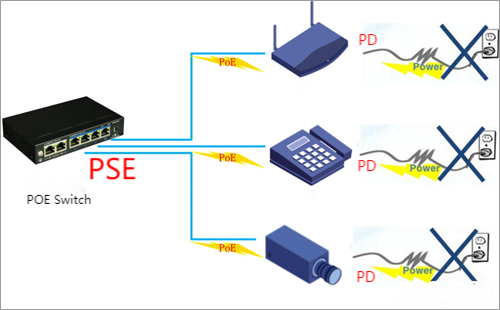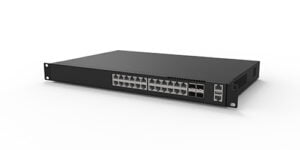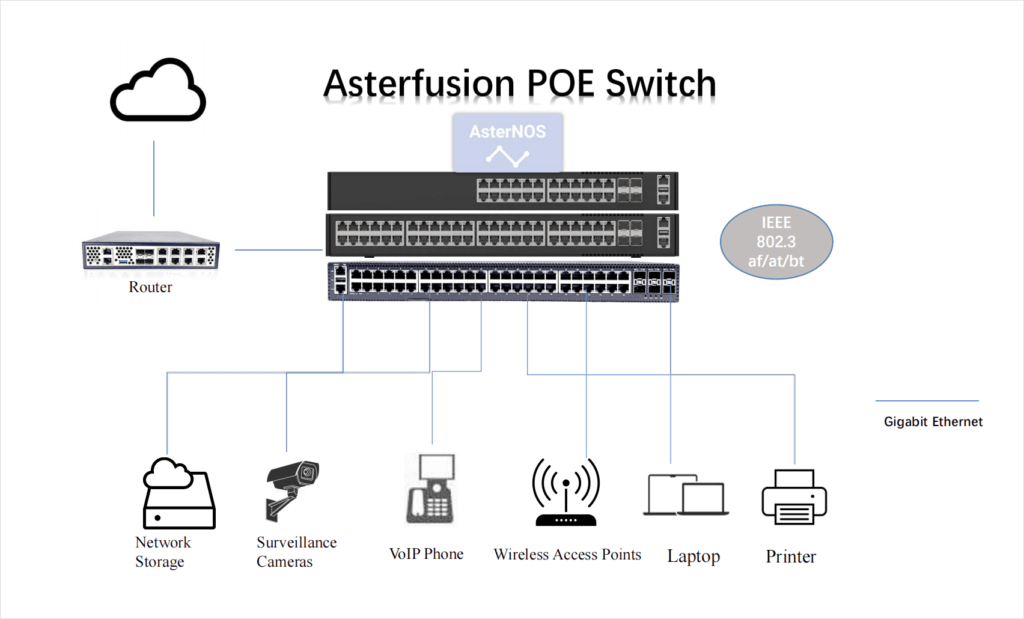PoE (Power over Ethernet) refers to a technology that transmits electric power and data simultaneously over twisted-pair Ethernet cable to IP terminal devices.
We often hear a device called “POE switch” in the construction of wireless WiFi in large and medium-size places or the construction of video transmission network for security monitoring. So, what is a POE switch and how does it work? In this article, let’s find out together.
What is Power over Ethernet (PoE) Technology ?
PoE (Power over Ethernet) refers to a technology that transmits electric power and data simultaneously over twisted-pair Ethernet cable to IP terminal devices (such as IP phones, APs, IP cameras, etc.) PoE technology enables the security of existing structured cabling while ensuring the normal operation of the network, which greatly minimizing costs.
Why PoE Switch?
With the rise of the Internet of Things (IoT) and smart cities, there are more and more mobile terminals such as wireless APs, cameras, and IP phones,the deployment location of this type of terminal is very flexible, and the way of power supply by wires is difficult, resulting in high wiring costs.
In addition,in many large-scale local area network applications, administrators need to manage multiple terminal devices at the same time. These devices require unified power supply and management. Due to the limitation of power supply location, it brings great inconvenience to power supply management. Based on this, the requirement to provide power support through Ethernet itself is becoming increasingly urgent. Power over Ethernet just solves the above needs.

How does PoE Switch Work?
In a PoE system, a device that provides power is called a Power Sourcing Equipment (PSE), and a PSE is generally a PoE switch.
Devices that use power are called Powered devices (PD), such as wireless APs, cameras,IP phones and other Powered devices.PD is divided into standard PD and non-standard PD according to whether it complies with IEEE standards.

PoE Standards Introduction
In order to standardize the development of PoE power supply technology, and to solve the compatibility problem between power supply and powered devices from different manufacturers, IEEE Standards Committee has released three PoE standards: from 802.3af in 2003 to 802.3at in 2009, and then to the latest 802.3bt in 2018, the new standard is backward compatible.

IEEE 802.3af
IEEE 802.3af, also known as standard PoE, has a supply voltage of 44-57V and a supply current of 10-350mA. It specifies that PSE devices need to provide up to 15.4W of DC power on each port. However, some power is lost on the Ethernet cable in actual transmission. Thus, only 12.95W is available to the powered device. It can support VoIP phones, APs, etc.
IEEE 802.3at
In October 2009, in order to meet the needs of high-power terminals, the IEEE 802.3at standard was born. On the basis of being compatible with the 802.3af standard, the IEEE 802.3at standard provides up to 30W of power to meet new needs.Its supply voltage of PoE+ ranges from 50V to 57V and the supply current is about10-600mA. Due to power loss, the guaranteed minimum output power on each port is 25W.This type can support devices that require more power like tablets, alarm systems, etc.
IEEE 802.3bt
In September 2018, the IEEE Standards Committee released the IEEE 802.3bt standard to further improve PoE power .It further enhances the power supply capability, with Type 3 providing up to 51 W power supply and Type 4 providing up to 71.3W power supply. Also included support for 2.5GBASE-T, 5GBASE-T, and 10GBASE-T, expanding the use of applications such as high-performance wireless access points and surveillance cameras and other applications.
Generally, IEEE 802.3af standard is called PoE power supply, the IEEE 802.3at standard is called PoE+ power supply, and the IEEE 802.3bt standard is called PoE++ power supply, also known as 4PPoE. The parameters corresponding to the three power supply technologies are shown in the figure below.

Asterfusion Network Switches Comply with Various PoE Standards
Asterfusion now has 24 port Gigabit /48 port Gigbit PoE /PoE+/POE++ switches that follow with the PoE standard for greater security and better functionality.
These open network switches are preloaded with a feature-rich SONiC NOS ( AsterNOS ) which is a container-based application deployment . It makes the switch easy to expand new functionalities even by users. It supports wire-speed Layer 2 switching and Layer 3 routing with MC-LAG feature, comprehensive QoS, advanced security and complete network management .Asterfusion PoE/PoE+ /POE++ switches can power any 802.3af or 802.3at 802.3bt device of the market, enable them flexible and secure.
Asterfusion 24 Port Gigabit PoE+ Switch /Asterfusion 48 Port Gigabit PoE+ Switch
The Following Table lists Asterfusion 24/48 Ports Gigabit PoE/PoE+/POE++ Switches.
| PoE Standard | Asterfusion PoE Switch Model | Port | Switch Capacity | Power Budget | PSU | Fans |
| 802.3at | CX102S-8GT-M-SWP | 8x1GBase-T, 2x10Gb SFP+ ports | 28Gbps | 150W | 1 | 2 |
| 802.3at/bt | CX102S-16GT-M-SWP | 16x1GBase-T,2x10Gb SFP+ ports | 36Gbps | 150W | 1 | 2 |
| 802.3at/bt | CX102S-16GT-DPU-M-SWP | 16x1GBase-T, 2x10Gb SFP+ ports | 36Gbps | 150W | 1 | 2 |
| 802.3at/bt | CX204Y-24GT-M-SWP2 | 24x1GBase-T,4x25Gb/10Gb SFP28 ports | 124Gbps | 370W | 1 | 3 |
| 802.3at/bt | CX204Y-48GT-M-SWP4 | 48 x 1G base-T , 4 x 25GE SFP28 ports | 148Gbps | 740W | 1 | 3 |
| 802.3at/bt | CX206Y-48GT-M-HWP4 | 48x1G BASE-T ,6x25Gb/10G SFP28 ports | 198Gbps | 740W | 2 | 3 |
| 802.3at/bt | CX206Y-48GT-M-HWP8 | 48x1G BASE-T ,6x25Gb/10G SFP28 ports | 198Gbps | 1440W | 2 | 3 |
Today, more and more loT projects such as smart cities and smart buildings needs POE switch, It shows greater growth potential. The PoE standard specifies the maximum power output of the PSE, which helps protect PoE-enabled devices from high voltage damage. Additionally, PoE switches simplifiy cabling installation and help enterprise users save costs.
If you are interested in Asterfusion POE switches, please email us bd@cloudswit.ch.
Related Products
-
 16x1G RJ45 POE+@150W L2/3 Access Switch, 2x10Gb SFP+ Uplinks, 2 Optional 4-core ARM DPU, Enterprise SONiC Ready
16x1G RJ45 POE+@150W L2/3 Access Switch, 2x10Gb SFP+ Uplinks, 2 Optional 4-core ARM DPU, Enterprise SONiC Ready -
 8x1G RJ45 POE+@150W L2/3 Access Switch, 2x10Gb SFP+ Uplinks, Enterprise SONiC Ready
8x1G RJ45 POE+@150W L2/3 Access Switch, 2x10Gb SFP+ Uplinks, Enterprise SONiC Ready -
 16x1G RJ45 POE+@150W L2/3 Access Switch, 2x10Gb SFP+ Uplinks, Enterprise SONiC
16x1G RJ45 POE+@150W L2/3 Access Switch, 2x10Gb SFP+ Uplinks, Enterprise SONiC -
 48x1G RJ45 POE+@740W/1440W L3 Access Switch, 6x25Gb/10Gb SFP28 Uplinks, Enterprise SONiC Ready
48x1G RJ45 POE+@740W/1440W L3 Access Switch, 6x25Gb/10Gb SFP28 Uplinks, Enterprise SONiC Ready -
 48x1G RJ45 POE+@740W L3 Access Switch, 4x25Gb /10Gb Uplinks, Enterprise SONiC Ready MLAG VXLAN Support
48x1G RJ45 POE+@740W L3 Access Switch, 4x25Gb /10Gb Uplinks, Enterprise SONiC Ready MLAG VXLAN Support -
 24x1G RJ45 POE+@370W/740W L3 Access Switch, 4x25Gb/10Gb SFP28 Uplinks, Enterprise SONiC Ready
24x1G RJ45 POE+@370W/740W L3 Access Switch, 4x25Gb/10Gb SFP28 Uplinks, Enterprise SONiC Ready -
 48x1G RJ45 POE+@1440W L3 Access Switch, 6x25Gb/10Gb SFP28 Uplinks, Enterprise SONiC Ready, MLAG VXLAN Support
48x1G RJ45 POE+@1440W L3 Access Switch, 6x25Gb/10Gb SFP28 Uplinks, Enterprise SONiC Ready, MLAG VXLAN Support




